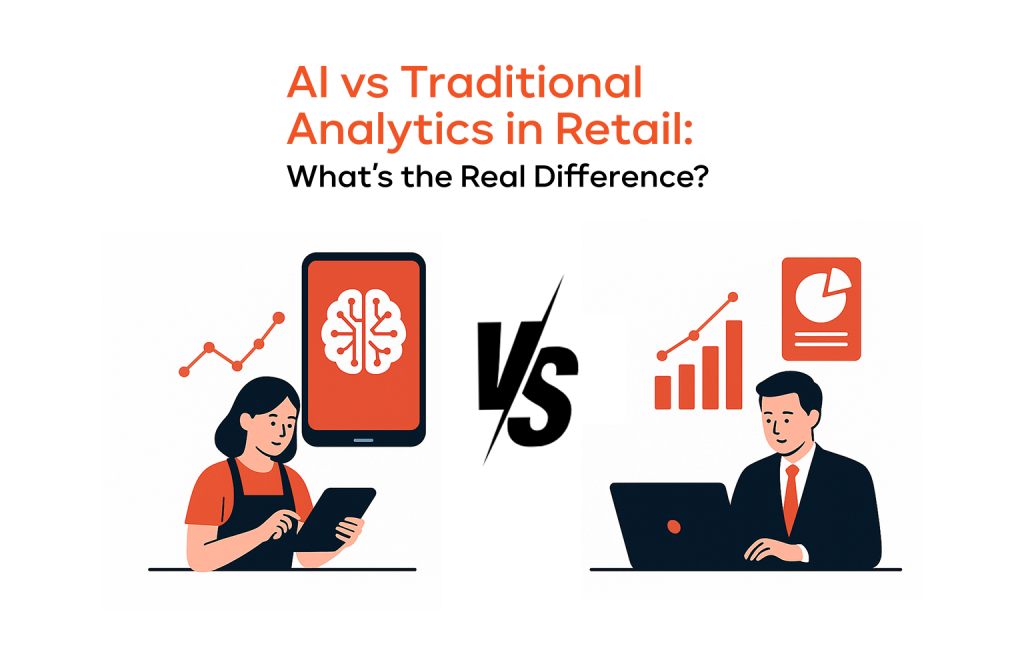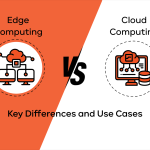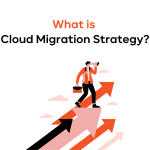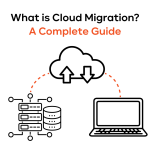The retail world is full of data. Every sale, click, and scroll creates tons of information. For today’s retailers, this data is vital for making decisions. But just having data isn’t enough. The real challenge is turning this huge amount of information into clear, useful insights that help businesses grow and make customers happier.
For decades, traditional analytics helped businesses understand “what happened.” It showed them the past. But in today’s fast market, AI-powered analytics is changing things. This new approach actively shapes the future by predicting outcomes and suggesting actions.
This article compares traditional analytics vs AI analytics. We’ll show their key differences, unique strengths, and how each impacts business. Get ready to see how retailers can move from reporting the past to creating their future with AI.
Retail is drowning in data – are you getting real insights?
Think about your last shopping trip. Every step left a digital trace. Modern retailers gather huge amounts of data:
- Sales: What you bought, when, and how much.
- Customer behavior: Clicks, page views, time spent, cart items.
- Supply chain: Stock levels, shipping, and delivery times.
- Social media: Mentions, feelings, trends.
- IoT devices: In-store foot traffic, sensor data, smart shelf patterns.
The problem? Raw data doesn’t automatically mean useful insights. It’s like a giant library without a way to find books – the knowledge is there, but finding something useful is hard.
Many retailers still rely on dashboards and reports. These are helpful but mainly show what happened. They tell you sales were up, or a product did poorly. But they don’t always say why, or more importantly, what will happen next, or what you should do. This is where AI changes the game. AI brings the power to predict and suggest actions, helping retailers move from reacting to foresight.
Defining the terms: Traditional analytics vs AI
Let’s clearly understand retail analytics with AI vs analytics in its traditional understanding. People often use these terms interchangeably. However, their main jobs and uses are different.
What is traditional analytics?
Traditional analytics focuses on understanding old data. It looks backward to describe events and find causes. Think of it as the basic foundation of business information, showing “what happened” and often “why.”
- Descriptive analysis answers “what happened?” (e.g., last month’s sales).
- Diagnostic analysis answers “why did it happen?” (e.g., checking if a campaign affected sales).
These analyses use common tools:
- BI tools: Software like Tableau or Power BI for data visualization.
- SQL Queries: To get data from databases.
- Excel: For smaller data analysis.
- Static dashboards: Fixed summaries of key numbers.
Insights from traditional analytics usually look to the past. They need human analysts or consultants to interpret and decide. While key for reporting, it lacks the ability to guess future trends or automate decisions.
What is AI/ML-powered analytics?
AI/ML-powered analytics is a big leap forward. It doesn’t just crunch old numbers. It builds systems that can learn, find hidden patterns, predict outcomes, and even suggest or automate actions.
- Predictive analytics answers “what will happen?” (e.g., guessing future sales, customer churn).
- Prescriptive analytics answers “what should we do?” (e.g., suggesting price changes or marketing campaigns).
These advanced abilities come from smart techniques:
- Machine learning models: Algorithms that learn from data without explicit programming.
- Natural Language Processing (NLP): Allows AI to understand human language, vital for checking customer feedback or chatbot talks.
- Automation: AI can make data processing, finding insights, and some decision-making automatic.
A key difference for AI is its ability to constantly learn and adapt. This means AI models become more accurate and insightful over time, refining their understanding of complex retail settings.
_______________________________________________________________________
Ready to change your retail operations with AI?
Don’t fall behind. Contact IT-Magic today for a talk and see how we can help you use the latest AI analytics solutions. We help firms like yours use their data for top competitive advantages.
_______________________________________________________________________
Key areas of difference
The difference between traditional analytics vs AI analytics impacts how a retailer operates and competes.
Data processing & scale
- Traditional analytics:
Best for structured data (like spreadsheets). Uses batch processing, handling data all at once after collection. It struggles with huge, fast, or varied data sets. For example, processing every click on a global e-commerce site in real time is too much.
- AI analytics:
Handles huge amounts and many kinds of data. AI systems can take in large, messy, and mixed data sources. This includes:
- Text: Reviews, social media opinions, chatbot talks.
- Images: Checking product pictures, finding visual trends, or understanding customer types from in-store video patterns (ethically).
- IoT signals: Data from smart shelves, sensors.
- Streaming data: Constant flows from websites and apps.
Imagine checking thousands of posts hourly for product sentiment, or processing video data to understand store traffic. These tasks overwhelm traditional analytics.
Speed & real-time decision making
- Traditional analytics:
Insights often come late. Manual reports or overnight processing mean trends can be old news. A weekly sales report won’t show if a pricing error is hurting sales right now.
- AI analytics:
Allows for real-time data flow and analysis. Data is processed as it arrives, letting businesses respond instantly.
- Dynamic pricing: Prices adjust instantly based on demand, competitor prices, or stock.
- Fraud detection: Suspicious deals are flagged in milliseconds.
- Personalized offers: Website offers change instantly based on real-time customer behavior.
This instant feedback helps retailers make quick decisions, using chances or stopping problems fast.
Accuracy & insight depth
- Traditional analytics:
Accuracy depends on data quality and fixed models. Flawed data or models can give wrong insights. A simple average might miss crucial, small changes.
- AI analytics:
Adaptive models improve accuracy over time through constant learning. As more data flows in, AI refines its algorithms and techniques. It finds deeper, more complex links and patterns that human analysts or simpler statistical methods might miss.
In retail, AI can spot tiny buying trends, like a sudden rise in accessory sales with certain clothes, before they become obvious. It finds nuanced customer preferences, leading to more exact marketing and product development. This deep data dive offers a big competitive edge.
Automation
- Traditional analytics:
Involves much manual effort. Data preparation, report making, and interpretation often need human analysts to spend a lot of time.
- AI analytics:
Offers wide automation throughout the data process.
- Automated data ingestion: AI pulls data from sources without manual help.
- Anomaly detection: Flags unusual data points (fraud, errors, sudden customer shifts).
- Personalization: Automatically delivers tailored content and offers.
- Predictive alerts: Warns teams about problems (stockouts, delays, unhappy customers) before they get critical.
This automation frees up human workers. Analysts can focus on strategy and innovation, using the rich insights from AI instead of routine reporting.
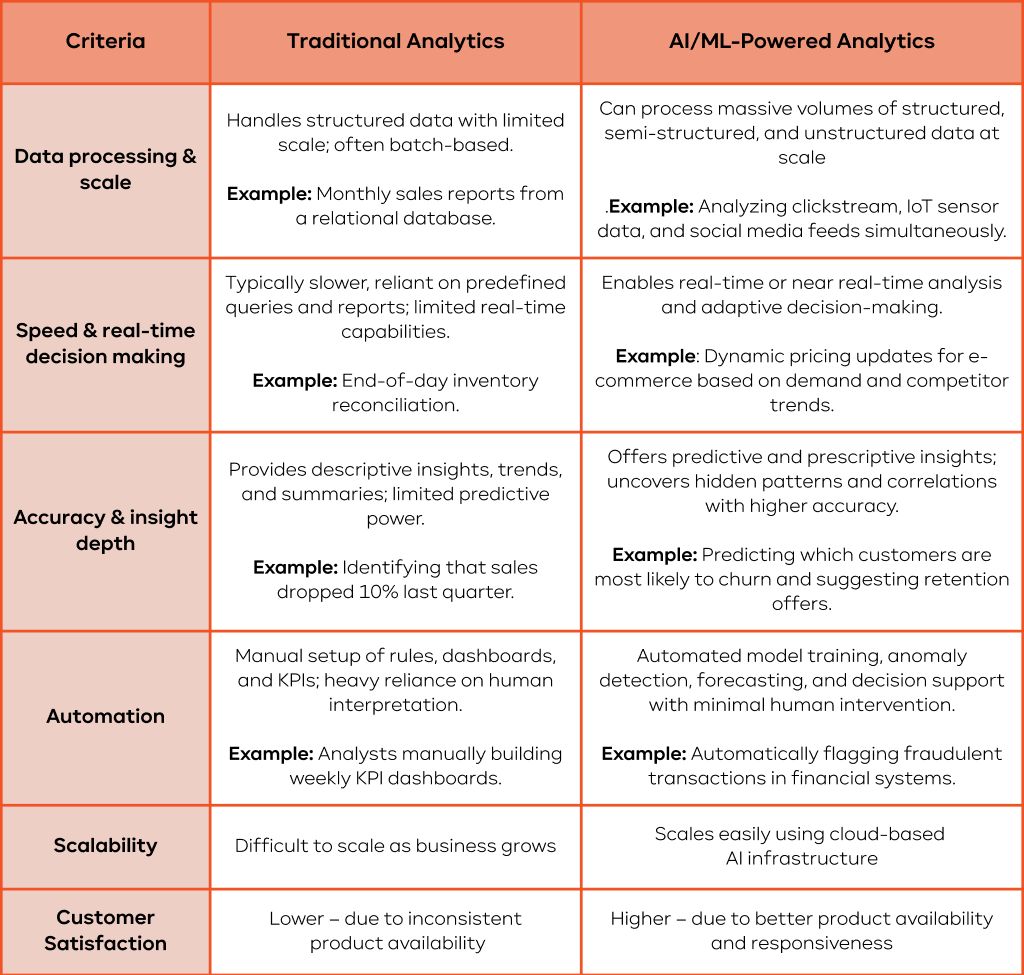
Real-world use cases: Traditional analytics vs AI in action
Let’s see these differences in retail examples. We’ll compare traditional analytics to AI in key retail jobs.
Product recommendations
- Traditional analytics:
Uses rule-based systems (“people who bought X also bought Y”). These rules are often fixed and broad, leading to general suggestions that might not feel personal.
- AI analytics:
Uses dynamic, personalized recommendation engines (like Amazon Personalize). AI checks many data points: past buys, browsing, real-time clicks, even weather. It adjusts recommendations instantly, learning from every interaction. For a clothing store, it might suggest a full outfit based on one shirt, considering style, brand, and weather.
Inventory forecasting
- Traditional analytics:
Guesses stock based on past sales averages. Struggles with sudden changes and outside factors.
- AI analytics:
Uses advanced demand forecasting models. These go beyond averages, including many factors:
- Seasonality: Yearly and monthly sales cycles.
- Promotions: Impact of sales events.
- Market signals: Economy, competitor actions, social media.
- Weather data: Predicting demand based on forecasts.
- Supply chain disruptions: Considering possible supplier delays.
By checking these many data streams, AI gives much more accurate forecasts. This reduces items running out and cuts down on too much stock, boosting profits.
Customer segmentation
- Traditional analytics:
Groups customers by broad details (age, location) or RFM (Recency, Frequency, Monetary). Useful for basic targeting, but these groups can miss individual customer differences.
- AI analytics:
Creates very personalized micro-segments. AI groups customers by hundreds of features:
- Behavioral data: Browsing patterns, purchase order, content viewed.
- Contextual data: Device used, time of day, how they found the site.
- Real-Time data: Current actions, recent interactions.
This leads to very detailed groups, almost one-to-one personalization. A retailer might find “eco-conscious urban cyclists who shop Tuesdays after 6 PM for sustainable athletic wear,” allowing very exact marketing.
Fraud detection
- Traditional analytics:
Uses fixed rules (e.g., flagging large transactions or many transactions from different places). Good for known fraud patterns, but new fraud techniques can bypass them, leading to many false alarms.
- AI analytics:
Uses anomaly detection and pattern recognition to find fraud in real time. ML algorithms learn from huge amounts of real and fake transactions, finding differences from normal behavior.
- It spots small, new fraud patterns not in rules.
- It checks connections between data points (IP, device ID, past buys) to give a real-time fraud score.
This active approach cuts fraud losses and improves security for retailers and their clients.
Chatbots
- Traditional analytics:
Often uses set decision trees. Customers choose from menus and get limited answers. If their question doesn’t fit, the bot fails, needing human help.
- AI analytics:
Powers NLP-driven conversational chatbots. These bots understand natural language, context, and talk in a more human-like way.
- They learn from talks, getting better at answering questions and solving problems.
- They can access huge info bases and connect to other systems for personalized help, order checks, or product info.
This creates a richer customer experience, cuts human customer service load, and provides instant, 24/7 support.
AWS tools enabling the shift from traditional to AI analytics
Moving from traditional analytics to AI-powered analytics doesn’t mean starting from scratch. AWS offers many tools to help. Retailers can use strong AI without huge upfront hardware costs or big data science teams.
Data warehousing and processing
Good analytics starts with data. AWS stores, processes, and prepares your data, structured or unstructured.
- Amazon Redshift: A fast, managed cloud data warehouse for large, complex data analysis. Great for structured data and queries.
- AWS Glue: A serverless data integration service. It makes it easy to find, prepare, and combine data for analytics. Excellent for ETL tasks, cleaning, and transforming data.
- Amazon S3: Object storage with top scalability, availability, security, and performance. Often, a data lake for all your data types, crucial for AI which needs diverse data.
Machine learning and model deployment
Once data is ready, AWS offers powerful services for building, training, and deploying ML models.
- Amazon SageMaker: A managed service for developers and data scientists to build, train, and deploy ML models fast. It smooths the entire ML process.
- Pre-trained models and AutoML options: For retailers without big data science teams, AWS offers ready-to-use AI services (e.g., image recognition). AutoML features in SageMaker can automate parts of model building, making AI easier.
AI services for retail
AWS offers special AI services for retail, hiding much of the ML complexity.
- Amazon Personalize: Real-time personalization and recommendation service. Uses ML for unique recommendation engines, like Amazon.com’s.
- Amazon Forecast: Managed service using ML for accurate forecasts. Perfect for demand prediction, planning, and inventory.
- Amazon Rekognition: Adds image and video analysis to apps. Retailers use it for product tagging, content moderation, or in-store video patterns (with privacy).
- Amazon Comprehend: NLP service using ML to find insights in text. Great for sentiment analysis, finding key items in reviews, or sorting support tickets.
- AWS Generative AI services: They allow new solutions like dynamic marketing text, realistic product images, or very smart conversational AI. Learn how we use AWS Generative AI services for our clients.
Visualization and BI integration
- Amazon QuickSight: Scalable, serverless, embeddable, ML-powered BI. It helps create interactive dashboards and reports. Connects directly with AI outputs, letting business users easily understand complex AI insights visually.
Real-time data streams
For immediate action, AWS handles data in motion.
- Amazon Kinesis: Collects, processes, and analyzes real-time streaming data. Critical for fraud detection, dynamic pricing, or instant personalization.
- AWS Lambda: Serverless compute service to run code without managing servers. Often used for event-driven data processing, reacting instantly to data streams.
By combining these AWS tools, retailers build a strong, scalable, and smart analytics setup that goes far beyond traditional analytics.
Business impact of moving to AI analytics
The shift to AI-powered analytics isn’t just new tech; it changes how retail businesses operate and compete. The potential impact is huge, touching every part of the company.
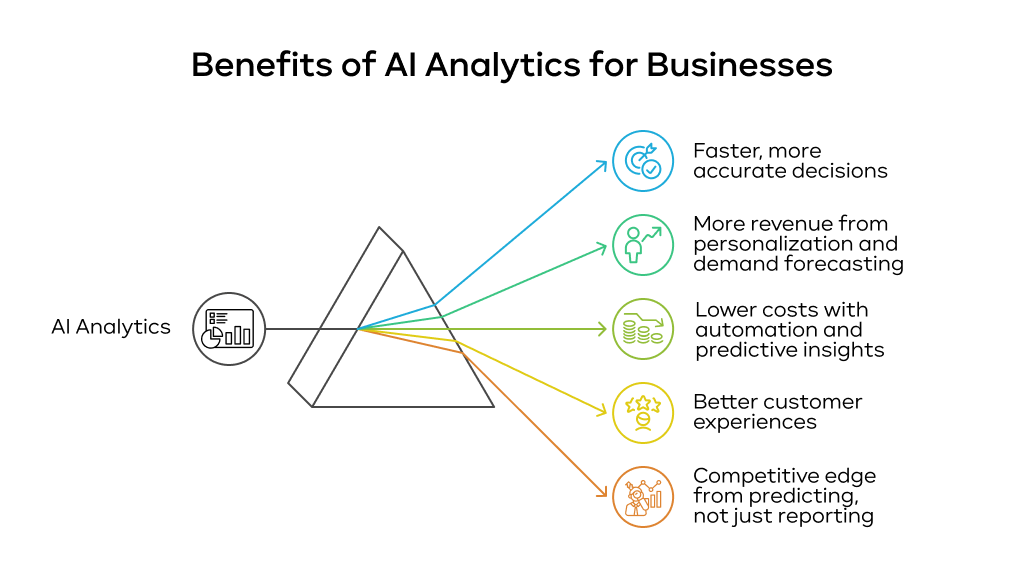
- Faster, more accurate decisions:
AI gives real-time, detailed insights and predictions. Leaders make decisions based on what’s next, not just reacting. This speed is vital in changing markets.
- More revenue from personalization and demand forecasting:
Personalization: AI-driven suggestions, custom offers, and tailored marketing lead to more sales and higher order values. Accenture found 91% of consumers prefer brands with relevant offers.
Demand forecasting: Better guesses mean fewer lost sales from stockouts and less discounting on excess stock, boosting income.
- Lower costs with automation and predictive insights:
Automation: Tasks like data preparation, reports, and some customer service can be automated, cutting labor costs.
Predictive maintenance: For retailers with logistics or in-store gear, AI predicts failures, cutting downtime and repairs.
Optimized inventory: Better forecasting means smarter stock, lower carrying costs, and less waste.
- Better customer experiences (recommendations, chatbots, proactive service):
Seamless recommendations: Customers get useful suggestions, making shopping better.
Intelligent chatbots: Instant, accurate help improves satisfaction and reduces frustration.
Proactive service: AI finds issues (like delivery delays) and lets retailers tell customers early, turning a problem into a positive. This builds loyalty.
- Competitive edge from predicting, not just reporting:
In a crowded market, guessing market shifts, customer needs, and challenges before rivals is a big advantage. Retailers using AI innovate faster, react quicker, and optimize with foresight that traditional analytics can’t match. This steady quality of insight gives a strong, long-term edge.
The benefits go beyond numbers. It builds a data-focused culture, empowers teams, and positions the retail firm for growth and innovation.
Challenges and considerations
AI analytics is powerful, but it’s not a magic fix. Using these solutions comes with challenges needing careful planning.
- Data quality and integration:
AI models depend on good data. If your data is messy, incomplete, or spread out, AI will struggle to give useful insights.
Challenge: Many retailers have old systems and messy data. Combining these sources into clean data for AI is a big job.
Consideration: Invest in strong data management, MDM tools, and ETL pipelines (like AWS Glue). This ensures clean, usable data, a must for AI success.
- Cost and resource investment:
Building and keeping AI solutions needs big investments in tech, infrastructure, and people.
Challenge: Cloud services cut hardware costs, but ongoing costs for cloud, software, and data science talent can be high. Many retailers lack in-house AI expertise.
Consideration: Start with small projects to show value. Partner with AI consultants like IT-Magic. They provide expertise in implementing and managing complex systems. This helps manage costs and get value faster.
- Change management:
Introducing AI changes how work is done and job roles. Employees might resist or fear job loss.
Challenge: Getting teams to trust AI, adapt to new data ways, and learn tools is hard. Without buy-in, AI can fail.
Consideration: Foster learning and experiments. Train employees on AI tools and how AI helps their roles. Stress that AI boosts human skills, freeing them for strategic work.
- Regulatory and Ethical Considerations:
Using AI with customer data brings up privacy, bias, and explainability concerns.
Challenge: You must follow privacy rules (GDPR, CCPA), prevent AI bias, and explain AI decisions.
Consideration: Prioritize ethical AI. Use data anonymization and privacy techniques. Regularly check AI models for bias and ensure transparency. Work with legal teams on rules.
Addressing these challenges early is key to successful AI use and getting the most benefits from advanced analytics in retail.
Final thoughts: Don’t just report the past – predict the future
In retail, just knowing “what happened” isn’t enough. Traditional analytics gave us insights, but its backward focus limits market’s need for speed and foresight.
The future of retail analytics is AI. The shift to predictive AI isn’t just an upgrade; it’s a fundamental change. It lets retailers move beyond reporting to shaping the future. With AI, businesses guess market shifts, predict customer needs accurately, personalize widely, and automate tasks. This frees human expertise for higher-value work. This ability to look ahead is the ultimate competitive edge.
It’s time for retailers to embrace this change. Start using AI-powered tools today, leveraging AWS solutions, to future-proof your analytics strategy. The results will speak for themselves.
Don’t just track history; make it!
Our experts can guide your retail business to thrive with AI-powered analytics in the predictive era.
FAQ
Can AI fully replace traditional analytics tools?
No, AI works with traditional analytics, not replacing it. Many businesses use both. Traditional analytics is good for basic reports and understanding past trends (“what happened”). AI then adds predictive (“what will happen”) and prescriptive (“what should we do”) powers. They work best together. Traditional analytics gives context and AI drives foresight and automation.
How does AI improve customer personalization compared to traditional methods?
Traditional methods use broad customer groups (like age, general buying history) for personalization. This often leads to common suggestions. AI, however, creates very detailed personalization. It processes huge amounts of real-time data. This includes individual browsing patterns, clicks, time spent, past buys, and outside factors. It builds detailed individual profiles, constantly learning and adapting. This helps it offer very relevant, one-to-one personalized suggestions and experiences instantly. This deep understanding of customer behavior is a key difference.
What AWS tools are best suited for AI-powered retail analytics?
AWS offers many services for AI-powered retail analytics. Key services include:
- Amazon Personalize for dynamic product suggestions
- Amazon Forecast for advanced demand prediction
- Amazon Comprehend for text analysis
- Amazon Rekognition for image/video analysis
Amazon SageMaker provides the platform to build, train, and deploy custom ML models. These AI services combine with basic data services: Amazon S3, AWS Glue, Amazon Redshift, Amazon Kinesis, and Amazon QuickSight.
